Contents
Tomatoes or tomatoes can rightfully be called very heat-loving crops that need to create certain greenhouse conditions. Although experts have bred many excellent varieties adapted to our climate, growing tomatoes in a greenhouse will still provide an opportunity to get a richer crop of vegetables than when they grow on open ground. It is only important to choose the right varieties, prepare the soil and plant seedlings, carefully care for it, so that later you can enjoy a good harvest of tomatoes.
Varieties for greenhouses
Growing tomatoes in a greenhouse involves creating conditions where they are reliably protected from rain, wind, frost, and so on. All this has a beneficial effect on their growth and development. If you do not exercise competent constant control over the microclimate inside the greenhouse – allow high humidity, which in turn can lead to rotting of tomatoes, sudden changes in temperature, especially in spring, overheating in the heat, the appearance of pests and diseases – then you will not be able to get a good and healthy crop . The agricultural technology of this culture, like many others, is a complex of important measures, the purpose of which is to achieve the desired result.
Growing tomatoes directly depends on whether the variety of vegetable crops is successfully selected. The optimal types of tomatoes that are advised to be planted in a greenhouse are those that have a strong immunity to diseases, easily tolerate temperature changes and some lack of light. The remaining selection criteria are very dependent on the type of shelter. These are the estimated sizes of the future bush, and the terms of its maturation.
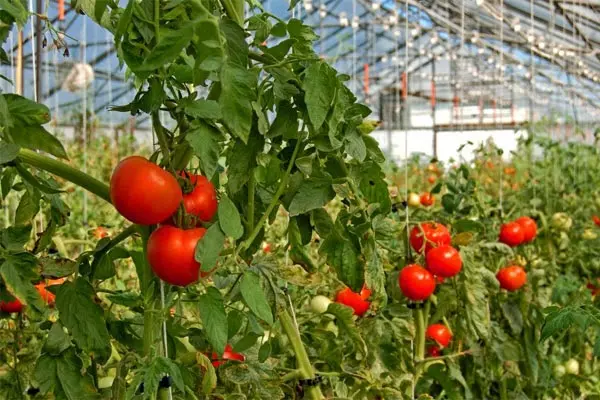
Experts recommend growing determinant and semi-determinant varieties of tomatoes in light seasonal greenhouses, since these types of vegetable crops are not very tall. They are able to grow in three summer months and give a good harvest. For such varieties of tomatoes, an early ripening period is characteristic, before the onset of severe frosts, all vegetables have time to ripen. In a larger capital greenhouse, growing tall indeterminate tomato varieties is best.
They need more space, and their period of growth and ripening of vegetables is longer. They need to be planted in early May, so that the bushes have time to form fruit brushes in the right amount. Since spring frosts are quite possible at this time, sometimes there is a need for an additional source of heating inside the greenhouse. If you decide to plant tall types of tomatoes in greenhouse conditions without heating, think about the possibility of creating the necessary temperature conditions indoors using stoves or modern electric heaters.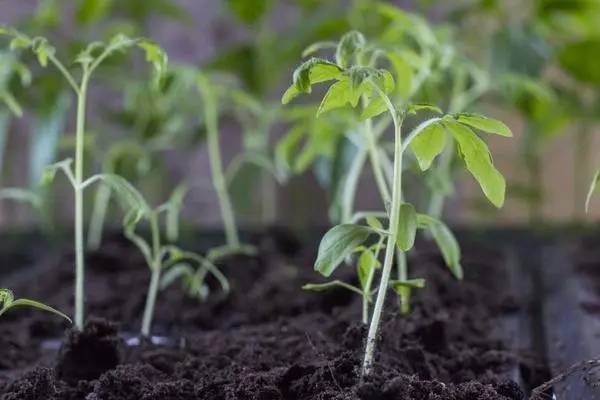
We are preparing the soil
Growing tomato seedlings begins in advance – just like preparing the land in a greenhouse.
Soil temperature for heat-loving tomatoes is no less important than indoor air temperature.
In no case should they be planted and grown in cold soil. Since seedlings can freeze, get sick and eventually die. The soil should be well preheated. It is easy to do this in a heated greenhouse, as well as when planting in May, when winter is already warming up without additional sources. But what if there is a desire to get a tomato crop early?
In this case, it is necessary to carefully close all the windows in the greenhouse, check that there are no cracks in the glass and a torn film. A greenhouse made of polyethylene or glass must be sealed with a second layer of film. 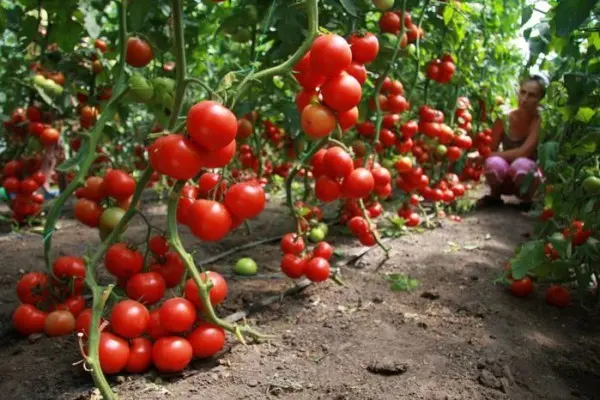 Inside, you need to loosen the soil, put a dense black film on top of it, under which, provided the doors are well closed, it will heat up to the optimum temperature. After a couple of days, the soil temperature can be checked with a thermometer. An indicator of +10 is considered acceptable for planting seedlings, and even better – +15 degrees.
Inside, you need to loosen the soil, put a dense black film on top of it, under which, provided the doors are well closed, it will heat up to the optimum temperature. After a couple of days, the soil temperature can be checked with a thermometer. An indicator of +10 is considered acceptable for planting seedlings, and even better – +15 degrees.
Experienced gardeners today prefer to create a greenhouse from modern polycarbonate material. It has become an excellent replacement for the obsolete and well-known plexiglass.
Polycarbonate is easy to process, provides good heating and illumination. In a polycarbonate greenhouse, you can warm up the soil using stove heating or installing a boiler. If a polycarbonate greenhouse is located next to a dwelling that has a gas boiler, the pipes can be brought into the greenhouse directly from the house.
Transplanting
Planting tomato seedlings in the greenhouse should ideally take place at the age of fifty days from the moment the sprouts emerge from the seeds. At the same time, their growth is approximately 30 – 40 cm. It is advised to keep them inside the greenhouse for a couple of days so that the plants can get used to the atmosphere of the room a little. How to properly place tomatoes in a greenhouse is decided by the owner himself, with an eye to the variety of vegetable crops, their dimensions and those vegetables that will grow in close proximity. You should not grow tomatoes and cucumbers in the same greenhouse, as their living conditions and care for them are very different. Also, situations should not be allowed when tall crops obscure low-growing crops.
Now you can begin to prepare the land and beds. After warming up the soil before planting seedlings, it must be carefully watered. Then holes are formed in the beds, in each of them you need to place a tablespoon of mineral fertilizer and pour it with a solution of potassium permanganate. Seedlings, together with the earth, should be planted in a prepared hole so that its cotyledon leaves remain on the surface of the earth. Then you need to pour the future tomato with warm water and sprinkle with soil. Immediately before planting seedlings in a greenhouse, it is customary to remove the lower leaves from her.
Care
Agrotechnics for growing a high-quality and rich crop of tomatoes is not so complicated as it might seem at first glance. It is necessary to adhere to all stages of seedling care in a greenhouse, which consist of creating the desired temperature indoors, a well-organized system of sufficient watering, feeding, self-pollination and timely pruning.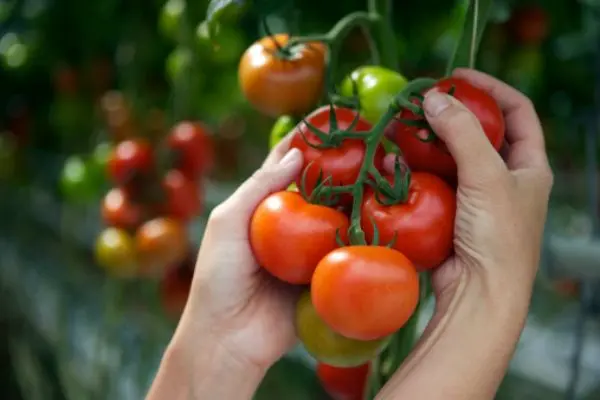
Temperature indicators for growing tomatoes in a greenhouse range from 23 to 26 degrees Celsius. The coating of the greenhouse itself plays a leading role in creating a normal temperature regime. It should be made not only from durable high-quality material, but also from one that will allow it to be heated normally and create conditions close to natural conditions for crops. Tomatoes should also be watered on time, but not excessively so that they do not start to crack.
And with insufficient moisture, an unpleasant change in the shape of the fruit may appear. The irrigation system should be chosen according to the variety of tomatoes. After all, some need water daily, while others can be watered once every couple of days. You can water the crops using a hose or bucket. This system is rarely used today. More modern watering is widely used today with the help of automatic equipment that is capable of turning it on and off on its own. There are subsoil, sprinkling and drip irrigation systems. In the first case, the pipes pass underground and the water flows directly to the roots of the tomatoes, in the second, pipes are placed along the perimeter of the greenhouse at the desired height, and their ends have nozzles through which water is supplied downward. With drip irrigation, water is supplied under the trunk in small portions.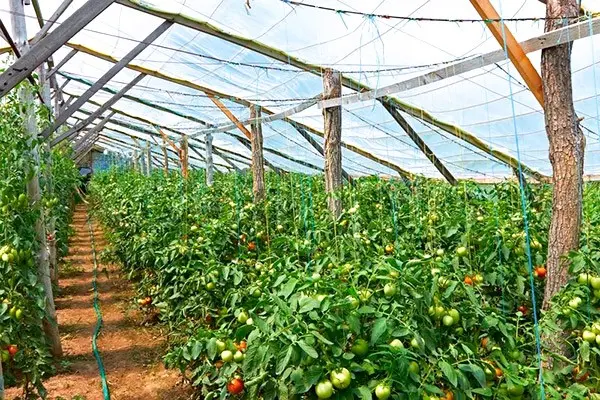
After the seedlings are accepted, it is advised to feed the tomatoes. The first time fertilizer is applied after raising the seedlings, and the second – when the first ties begin to appear. Any complex fertilizer must be taken approximately 0 kg per hectare of land. Well in this case, ammonia and calcium nitrate have proven themselves. For the possibility of self-pollination of crops in the greenhouse, vents are made. Pollen should be shaken off the flowers with a soft stick so that it settles on the ground. There are commercial products in which you can dip the flowers of tomatoes or spray them. The final stage of agricultural activities is the trimming of excess leaves and branches with a pruner. Such a process will help useful substances get into the middle of the fruit, and not the bushes.
Harvest
Harvesting is carried out as the vegetables ripen. There are several degrees of ripeness of tomatoes – green, milky, pink and full. Many people pick pink tomatoes and place them in a warm place to ripen.  If planting took place in winter, the first crop is harvested in the spring with a frequency of a couple of days. Tomatoes are recommended to be collected without stalks, put in boxes. Red tomatoes should be immediately removed from the bushes, otherwise they will become soft and tasteless. Harvesting is carried out until the temperature drops to zero at night, sometimes you can continue harvesting until the first frost appears.
If planting took place in winter, the first crop is harvested in the spring with a frequency of a couple of days. Tomatoes are recommended to be collected without stalks, put in boxes. Red tomatoes should be immediately removed from the bushes, otherwise they will become soft and tasteless. Harvesting is carried out until the temperature drops to zero at night, sometimes you can continue harvesting until the first frost appears.
Video “Growing a tomato”
On the recording, a man talks about how to grow tomatoes in greenhouse conditions.









